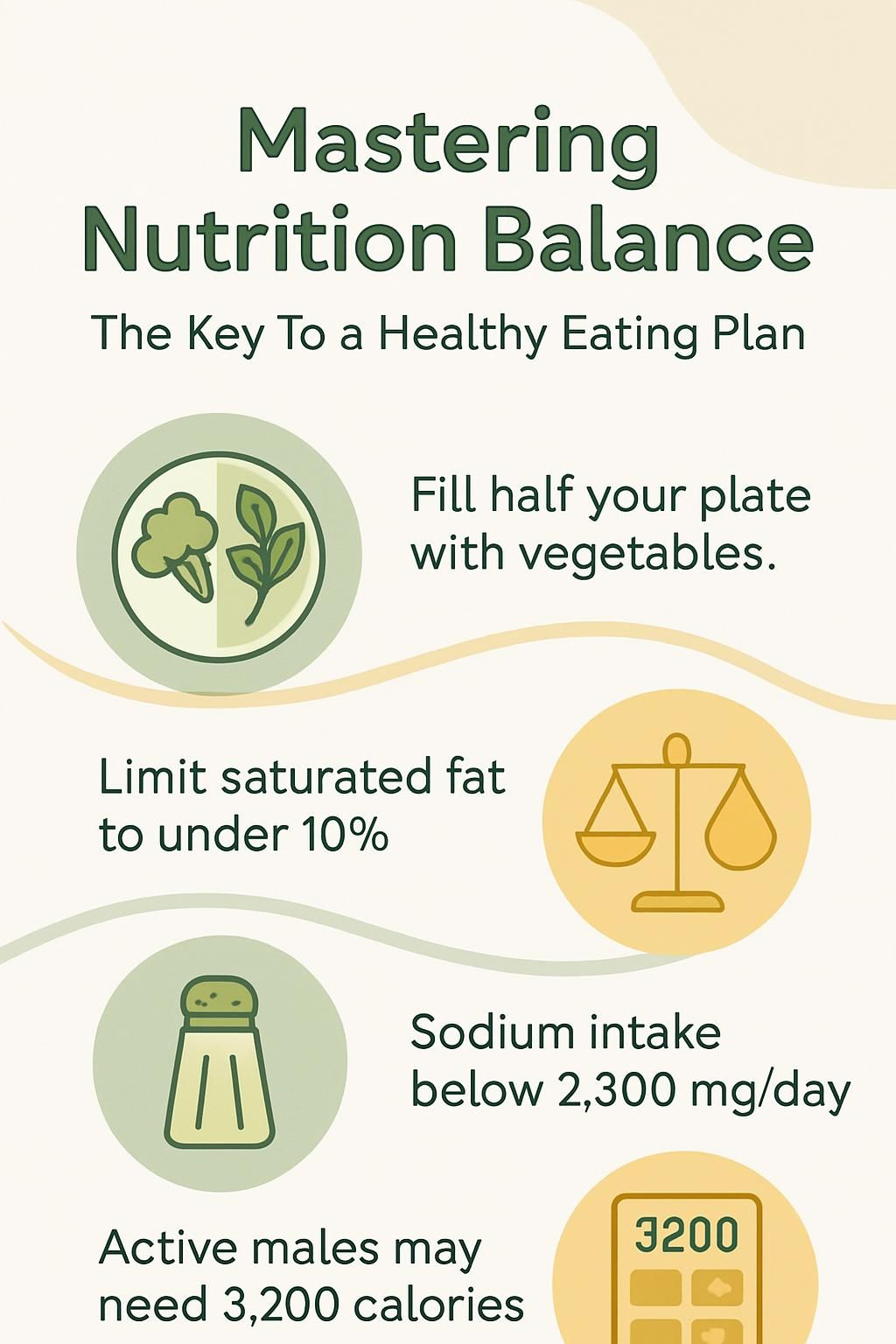Mastering Nutrition Balance: The Key To A Healthy Eating Plan
Our Nutrition Assistant AI Suite will transform your body. You will lose fat, get toned, and build muscle. Gain confidence and optimal health.
You face a lot of mixed messages about a healthy eating plan. It can feel hard to sort facts from trends. Solid nutrition balance, which means eating the right mix of foods, is the steady path that supports weight, heart health, and long-term wellness.
This guide breaks down core ideas, shows practical swaps you can use today, and explains helpful tools like MyPlate and the Healthy Eating Plate. Start small, build steady habits, and give your future self a stronger base.
Key Takeaways
- Nutritional balance means eating a variety from all five food groups. It is linked to lower risk of heart disease, type 2 diabetes, and early death (Harvard Chan School).
- Fill half your plate with fruits and vegetables, choose whole grains, and keep saturated fat under 10 percent of daily calories (USDA).
- People who follow the Healthy Eating Pyramid had up to a 20 percent lower risk for major chronic diseases in large studies of women.
- Read labels, keep sodium under 2,300 mg per day (CDC), avoid trans fats in processed snacks, and swap sugary drinks for water.
- Match calories to your age and activity. Active males 14–30 may need up to 3,200 calories, while many sedentary adults do well with 1,600–2,400.

What is Nutritional Balance?

Nutritional balance means getting the right mix of nutrients from different food groups each day. A healthy diet helps you keep cholesterol, blood pressure, and weight in a safer range.
What does nutritional balance mean and why is it important?
Nutritional balance is eating a variety of foods in the right amounts so your body gets what it needs. You need macronutrients, which are carbohydrates, protein, and fat, and micronutrients, which are vitamins and minerals. You can get these from fruits, vegetables, dairy foods, lean meats, beans, nuts, and whole grains.
The United States Department of Agriculture encourages food group balance to prevent shortages or excesses that harm health. Too much saturated fat or added sugar raises the risk of obesity and cardiovascular disease. Too little fiber can slow digestion and affect blood sugar.
Balanced meals support steady energy and a healthy body weight. People who eat varied diets with proper portions lower their risk of type 2 diabetes and high blood pressure. Eating nutrient-dense foods helps your immune system and supports healthy cholesterol levels.
Dietitians at the Academy of Nutrition and Dietetics note that a healthy diet evolves over time, yet it always centers on variety. That mindset helps you build habits that last.
How do macronutrients and micronutrients affect nutrition?
Carbohydrates, protein, and fats are macronutrients your body needs in larger amounts. Carbohydrates give quick energy for daily tasks. Protein helps build muscle, repair tissues, and support immune function. Fats provide long-lasting energy and help cell health, but too much can lead to weight gain.
Health experts suggest keeping saturated fat below 10 percent of daily calories to reduce heart risk. Micronutrients include vitamins, minerals, and antioxidants. For example, vitamin C supports immunity, and calcium supports bones and nerve signaling.
Iron carries oxygen in your blood. If you fall short, you may feel tired and weak. Many people notice better focus after switching one processed lunch a day for whole grains, vegetables, and fruit. Nutrient-dense foods give steady fuel instead of sugar spikes.
Knowing how macros and micros work sets you up to apply the key principles of nutrition balance.
Key Principles of Nutritional Balance
Healthy eating starts with a few clear rules. Use them day to day to build a stronger pattern.
Variety: Incorporating diverse food groups
Eating from all five food groups helps you cover essential nutrients. Include fruits and vegetables, whole grains, legumes like beans and lentils, nuts and seeds, low-fat dairy or fortified alternatives, lean proteins like poultry or fish, and healthy oils such as canola or sunflower oil.
Pick local and seasonal produce when you can, since it is often more flavorful. Aim to fill half your plate with colorful fruits and vegetables. Potatoes do not count toward that half because they act more like a starch in the body.
Simple tools, like a food pyramid chart or nutrition calculator, can help you track group balance. Swapping regular pasta for whole grain versions raises fiber and supports heart health.
You improve nutrition balance by making meals colorful with plenty of plant foods.
Moderation: Avoiding excesses and deficiencies
Once variety is in place, focus on moderation. Too much total fat, added sugars, or sodium can drive up blood pressure and heart risk. Keep portions of calorie-dense foods reasonable.
Limit foods high in trans fats like some packaged snacks and fried items. Cook with vegetable oils or other unsaturated fats instead of butter. Keep milk or dairy to about 1–2 servings daily to meet calcium needs without overshooting calories. Choose water most days and cap juice at one small glass.
Cut back on sweetened drinks to lower sodium and sugar intake. Get plenty of fiber from whole grains and beans. Use dietary supplements only if a clinician or registered dietitian recommends them for your specific needs.
Proportion: Balancing macronutrient intake
Portion control helps you balance carbohydrates, protein, and fats. The Healthy Eating Plate and USDA MyPlate are useful guides. Fill half the plate with fruits and vegetables. Use just over one fourth for whole grains or other starches. Reserve the remaining quarter for lean proteins like fish, poultry, tofu, beans, or nuts.
Whole grains and vegetables add fiber for digestion and weight control. Choose healthy oils instead of butter or lard. Aim for two servings of oily fish each week to support heart health, as the American Heart Association advises.
Nutrient Density: Prioritizing nutrient-rich foods
Pick foods that give more nutrients per calorie. Choose brown rice, whole-wheat bread, and whole-grain pasta over refined options. These provide extra fiber, minerals, and vitamins.
Add protein sources such as lean meats, beans, lentils, or nuts. Limit “empty calorie” items like cakes, chips, fries, pizza, cookies, ice cream, and sugary drinks. A DASH-style eating pattern, which focuses on unprocessed foods, can support weight control and heart health.
Individual Needs: Tailoring plans based on age, lifestyle, and health
Your plan should fit your age, activity level, and health conditions. Sedentary children ages 2 to 8 often need 1,000 to 1,400 calories daily. Active female teens and young adults may need around 2,400 calories. Active males in that age range may need 2,800 to 3,200 calories.
Plant-forward or vegan eaters can meet protein needs with tofu, beans, lentils, and soy foods. If you have celiac disease, food allergies, or other medical needs, adjust choices with care. A registered dietitian can help personalize a safe, balanced approach.
What are the benefits of achieving nutritional balance?
A balanced diet makes everyday choices simpler. It supports your body and mind across school, work, and home.
How does nutritional balance support overall health and well-being?
Eating across all major food groups helps you meet needs for vitamins, minerals, fiber, protein, healthy fats, and complex carbohydrates. These nutrients build bones and teeth, support immunity, and lower infection risk.
People who follow a balanced diet report better daily energy and performance [1]. Using vegetable oils in place of animal fats can support heart health by lowering saturated fat intake. Watching total calories while choosing nutrient-dense foods can help you reach a healthy weight [2]. Fiber from whole grains and nuts helps you stay full longer [3]. Eating enough fruits and vegetables is linked to a lower risk of chronic illness [4].
Consistent choices, day after day, help your body handle stress and recover faster.
Citations:
1. Harvard T.H. Chan School of Public Health, The Nutrition Source.
2. Centers for Disease Control and Prevention, Healthy Eating for a Healthy Weight.
3. Mayo Clinic, Nutrition basics.
4. American Heart Association, Dietary Recommendations.
Can nutritional balance reduce the risk of chronic diseases?
Yes. Balanced eating can lower the risk of heart disease, some cancers, stroke, and type 2 diabetes. Harvard research shows that people who follow the Healthy Eating Pyramid or Plate have fewer major diseases and a lower chance of early death.
In one large study of 93,676 postmenopausal women, those with higher Healthy Eating Pyramid scores had fewer cardiovascular events than those following low-fat patterns. Diet quality matters more than just counting calories. People with high scores on the Alternate Healthy Eating Index saw up to 20 percent lower risk in men and 11 percent lower risk in women.
Choosing fiber-rich foods, healthy fats like those in nuts, whole grains, and plenty of fruits and vegetables helps your body fight disease.
How does it help maintain a healthy weight?
A balanced diet helps you manage weight because it delivers nutrients without excess calories. Fruits, vegetables, whole grains, beans, and lean proteins increase fiber and fullness, which reduces overeating.
Staying active supports a healthy body mass index. Choose brown rice, quinoa, and whole-grain breads over refined grains that digest quickly. Limit saturated fat, added sugar, and heavy condiments. Many packaged snacks are energy dense. Replacing them with nutrient-dense foods helps you reach and keep a healthy range.
What impact does it have on energy and mental focus?
Balanced eating steadies energy and helps prevent mid-day crashes. Fiber, healthy fats, and lean proteins slow digestion in a good way. That means more stable blood sugar and fewer slumps.
Vitamins and minerals also support brain function and focus. Children who lack key nutrients may struggle with learning and growth. A balanced pattern supports better thinking and active play.
How does it strengthen immunity and physical resilience?
Nutritional balance gives your immune system the raw materials it needs. Aim for at least five servings of fruits and vegetables daily. This habit is linked with lower risk of heart disease, stroke, and some cancers.
Vitamin C from citrus and leafy greens supports white blood cells. Whole grains feed your gut microbiome, which is tied to immunity. Lean proteins repair tissues, and healthy fats like olive oil help calm inflammation. Steady, varied meals help you recover faster after stress or illness.
Building a Healthy Eating Plan
A structured eating plan helps you increase fiber, manage calories, and protect your heart. You do not need perfection. You need a pattern you can repeat most days.
What are the main food groups and their roles?
Fruits and vegetables deliver fiber, vitamins, and antioxidants. Eating more of them lowers heart risk and can support weight loss. Grains provide energy, and whole grains add fiber for digestion and steady blood sugar.
Dairy or fortified alternatives supply protein, calcium, and vitamin D for bones. Protein foods like lean meat, eggs, fish, beans, nuts, and legumes repair muscles and support growth. Small changes, like moving to whole grains and adding produce at each meal, can boost energy for sports or work.
How can I incorporate more fruits and vegetables?
Once you know each food group’s role, put produce at the center of every plate. Use these simple ideas to reach your daily goal and support a balanced diet.
- Aim for at least five portions each day. This helps cover many vitamins, minerals, and fiber needs.
- Fill a little over one third of your total intake with fruits and vegetables.
- Use these serving sizes: 80 grams for fresh, canned, or frozen produce, 30 grams for dried fruit; limit juice or smoothies to 150 milliliters daily.
- Add sliced fruit to oatmeal or yogurt in place of sugary toppings.
- Snack on carrot sticks, cucumbers, or cherry tomatoes instead of chips.
- Add a side salad at lunch or dinner. Rotate greens like spinach or kale.
- Cook mixed vegetables in stir-fries or soups to boost color and nutrients.
- Choose canned or frozen options when fresh is limited. They still count and can save time.
- Swap rich desserts for fruit salad to manage calories while satisfying a sweet tooth.
- Carry portable fruit, like apples or clementines, to cut vending machine trips.
Why choose whole grains over refined grains?
Whole grains keep all parts of the seed, so they retain more fiber, vitamins, and minerals. Choose whole-wheat bread, whole-grain pasta, and brown rice instead of white bread or white rice.
The Dietary Guidelines for Americans recommend that at least half your grains come from whole sources. A single slice of whole-wheat bread can have nearly double the fiber of white bread. Fiber helps control blood sugar and keeps you full. This simple swap improves digestion and long-term health.
What are good sources of lean proteins and plant-based options?
After choosing whole grains, add quality proteins to round out your plate. Mix animal and plant options to get a wide range of nutrients.
- Fish, including salmon or sardines, provides lean protein and omega-3s. Aim for two portions weekly, with at least one oily fish.
- Skinless poultry such as chicken or turkey has less saturated fat than many red meats.
- Beans, peas, and lentils supply plant protein, fiber, and key minerals.
- Nuts and seeds add protein and healthy fats; sprinkle them on salads or snacks.
- Eggs contain all essential amino acids, which are the building blocks of protein.
- Tofu, tempeh, and soy foods are strong alternatives for vegetarian or vegan diets.
- Limit red meat and avoid processed meats like bacon and deli meats to reduce sodium and preservatives.
How do I select healthy fats in moderation?
Choose unsaturated fats most often. Use olive or canola oil in cooking instead of butter or heavy cream. Extra-virgin olive oil works well for dressings and low to medium heat.
Spread avocado on whole-grain toast in place of margarine. Keep saturated fat at or below 10 percent of daily calories. Replace it with vegetable and fish oils. Skip deep-fried foods since they pack many calories without helpful nutrients. Avoid trans fats in processed snacks. Cutting them supports heart health.
Why limit processed foods, sugar, and salt?
Processed foods are often high in added sugar and salt. Regular intake raises the risk of high blood pressure, weight gain, and some cancers. Processed meats like sausage and deli ham contain preservatives and excess sodium.
Sweet drinks add lots of calories but few nutrients. Diets high in added sugars are tied to obesity and diabetes. Swapping soda for water can stabilize energy and reduce cravings. Most of your diet should come from fresh or minimally processed foods like fruits, vegetables, whole grains, and lean proteins.
Summary: Key Risks of Excess Intake
| Food or Ingredient | Health Risk |
|---|---|
| Processed foods | Weight gain, higher cancer risk with some processed meats |
| Added sugar | Type 2 diabetes, excess calories, weight gain |
| Excess salt | High blood pressure, heart strain |
What are practical tips for maintaining nutrition balance?
Small actions, repeated often, make healthy eating easier. Use simple tools to stay on track even on busy days.
How can meal planning and preparation help?
Planning turns good intentions into daily wins. It reduces guesswork and keeps balanced options within reach.
- Plan meals before hunger hits to avoid last-minute fast food choices.
- Use the Healthy Eating Plate to build balanced mains, soups, and cultural favorites.
- Prep snacks and meals in advance so healthy choices are ready to grab.
- Shop with a list to skip ultra-processed snacks high in sugar, salt, or unhealthy fats.
- Control portions and calories by cooking at home.
- Include all food groups: fruits, vegetables, whole grains, lean proteins, and healthy fats.
- Stick to your list to save money and cut food waste.
- Track macronutrient balance with a portion plate or a simple app.
- Batch-cook on weekends so weekdays run smoothly.
- Adapt recipes for allergies or health needs without losing flavor.
- Use leftovers creatively to save time and reduce waste.
How do I read and understand food labels?
Labels help you compare products quickly. Start with the serving size, since all other numbers depend on it. Then look at calories per serving and decide if it fits your daily needs.
Check total fat, saturated fat, and trans fat. Keep unhealthy fats low. Watch sodium, since adults should stay under 2,300 mg daily, based on CDC guidance. Choose foods lower in added sugars.
Scan the ingredient list for short and familiar items. For plant milks, check calcium and added sugars. Many flavored varieties contain extra sugar. Switching to unsweetened options can cut daily intake.
Why is staying hydrated important and how to limit sugary drinks?
Hydration supports energy, digestion, and focus. Aim for 6 to 8 glasses of fluids each day. Water should be your main drink. Tea or coffee with little or no sugar can also fit.
Limit juice to one small glass per day. Sugary drinks raise the risk of weight gain, diabetes, and tooth decay. Choose water at meals and carry a refillable bottle. For a splash of flavor, add lemon slices or berries.
How can I make healthier choices when dining out?
Scan the menu for vegetables, whole grains, and lean proteins. Pick grilled fish or chicken instead of fried options. Choose brown rice when it is available.
Ask for a salad or vegetables as a side. Fresh fruit makes a lighter dessert. Portions can be large at restaurants. Order a half-portion or share a meal to manage calories. Checking the menu online ahead of time helps you decide faster. For example, grilled fish, brown rice, a salad, and fruit cover all major groups with fewer empty calories.
Summary: Favor vegetables, whole grains, and lean proteins, watch portions, and ask for lighter sides like fruit or salads.
When and how should I adjust portions and calorie intake?
Your needs change with age, activity, and health. Active males aged 14 to 30 may need 2,800 to 3,200 calories per day. Sedentary males in that range need about 2,000 to 2,600. Many sedentary adults over thirty do well with 1,600 to 2,400.
Notice how you feel during daily tasks and exercise. If you feel sluggish or your weight shifts quickly, adjust portions. Increase servings around intense training. Scale back on rest days. This flexible approach keeps nutrition aligned with energy use.
What are some examples of balanced meals?
Balanced meals do not need to be complex. These ideas combine whole grains, lean proteins, and produce for steady energy.
How to make grilled salmon with quinoa and steamed broccoli?
Grilled salmon with quinoa and steamed broccoli offers protein, fiber, and heart-healthy fats in one simple plate.
- Select a 4-ounce salmon fillet for lean protein and omega-3s.
- Brush with olive oil, then season with salt, pepper, and lemon juice.
- Heat a grill or nonstick pan over medium-high and cook 4–5 minutes per side, until the fish flakes.
- Rinse 1/2 cup dry quinoa, simmer with 1 cup water for about 15 minutes.
- Steam 1 cup broccoli florets for 5–6 minutes until crisp-tender.
- Plate quinoa, add the salmon, then the broccoli.
- Finish with a squeeze of lemon for brightness without added sugar.
This classic mix helps you meet daily nutrition goals with familiar flavors.
What is a balanced oatmeal with fresh berries and almonds?
Oatmeal with berries and almonds is a quick breakfast that delivers fiber, protein, and healthy fats.
- Cook whole grain oats in water or low-fat milk for a steady-energy base.
- Add a handful of berries for vitamin C, antioxidants, and natural sweetness.
- Top with chopped almonds for healthy fats, protein, and crunch.
- Use plain oats instead of flavored packets to reduce added sugars and sodium.
- Include about 1/4 cup berries per serving.
- Add 1 tablespoon almonds for a simple protein boost.
- Use cinnamon for flavor without extra calories. It may help with blood glucose control.
- Serve hot or chilled to fit your routine.
How to prepare lentil soup with whole-grain bread?
Lentil soup with whole-grain bread supplies plant protein, fiber, and complex carbs for a filling, budget-friendly meal.
- Rinse 1 cup dry lentils.
- Chop 1 onion, 2 carrots, and 2 celery stalks.
- Sauté vegetables in 1 tablespoon olive oil over medium heat for 5 minutes.
- Add lentils and 4 cups low-sodium vegetable broth.
- Season with 1 teaspoon cumin and 1/2 teaspoon black pepper. Simmer 30–35 minutes.
- Toast whole-grain bread for the side.
- Serve hot with lemon juice if you like.
- This meal fits busy weeks and encourages more plant-forward eating.
- One serving can provide about 18 grams of protein and 15 grams of fiber.
- Freeze extra portions for up to three months.
What does stir-fried tofu with colorful vegetables and brown rice include?
This plant-based bowl gives you protein, fiber, and a mix of vitamins in each bite.
- Tofu supplies complete plant protein, which supports muscle repair.
- Colorful vegetables, such as bell peppers and snap peas, add vitamins A and C.
- Brown rice provides complex carbs, B vitamins, and fiber.
- The mix of food groups boosts variety and nutrient density.
- Low saturated fat supports heart health.
- Ample fiber helps control hunger and supports stable energy.
How to serve Greek yogurt with fruit and granola?
This quick bowl works for breakfast, a snack, or a post-workout meal.
- Choose plain or low-fat Greek yogurt to keep added sugar low.
- Scoop 1 cup of yogurt into a bowl.
- Add 1/2 cup fresh fruit for vitamins, minerals, and color.
- Top with 2–4 tablespoons whole-grain granola for crunch and fiber.
- For extra nutrition, add a few sliced almonds or walnuts.
- Use a small drizzle of honey if you need added sweetness.
- Serve chilled for best texture.
- Layer the ingredients so the granola stays crisp.
- Protein from dairy, vitamins from fruit, and energy from whole grains make this a balanced option.
- Switch fruits with the seasons to keep meals interesting.
What are common challenges in nutrition balance and how can I overcome them?
Cravings, costs, time, and allergies are real barriers. A few small systems can make these hurdles easier to clear.
How to manage cravings and emotional eating?
Cravings and stress eating are common. Plan for them instead of hoping they will vanish.
- Track triggers with a food and mood diary.
- Pick fruit for sweet cravings to avoid sugar spikes.
- Eat regular meals with lean protein, whole grains, and healthy fats to prevent extreme hunger.
- Practice mindful eating. Put away screens and notice fullness cues.
- Use stress outlets like a walk, reading, or deep breathing.
- Drink water before snacking. Thirst can feel like hunger and a glass may curb intake at the next meal.
- Prep balanced snacks, such as yogurt or a small handful of nuts, so smart choices are easy.
What are budget-friendly strategies for healthy eating?
Healthy eating can fit your budget with planning and a few smart swaps.
- Shop farmers markets or discount produce sections for affordable seasonal items.
- Plan weekly meals to prevent impulse buys and waste.
- Buy basics like rice, oats, beans, and lentils in bulk.
- Use frozen produce when fresh is pricey. It is nutritious and lasts longer.
- Cook large batches of soups or stews and freeze extras.
- Choose lower-cost proteins such as eggs, canned tuna, tofu, and dried beans.
- Compare unit prices to find better value.
- Drink tap water instead of sugary drinks.
- Reduce processed foods, which often cost more per serving.
- Prep on weekends to save time and use what you buy.
- Pick in-season snacks like apples or carrots for better prices and taste.
How to overcome time constraints with quick meal ideas?
Time pressure is real. Keep a short list of fast options so you always have a plan.
- Batch-cook vegetables for the week, then reheat as needed.
- Add dried fruit to cereal for a quick vitamin and fiber boost.
- Swap packaged snacks for fresh fruit like bananas.
- Blend greens, frozen fruit, and yogurt or milk for a fast smoothie.
- Reheat homemade bean or lentil soups for easy lunches.
- Keep whole-grain bread on hand for nut butter or hummus sandwiches.
- Use pre-cooked proteins like grilled chicken or canned tuna for salads and wraps.
- Cook extra at dinner and pack leftovers for the next day.
- Make snack boxes with vegetables and a few nuts for grab-and-go fuel.
- Choose five-ingredient recipes, such as tofu, mixed vegetables, and brown rice.
How to address dietary restrictions or allergies?
If you have allergies or intolerances, plan ahead and read labels closely. Avoid hidden allergens like wheat, milk, eggs, peanuts, soy, fish, shellfish, and tree nuts. For lactose intolerance or plant-forward diets, try fortified milks like almond, soy, oat, cashew, flax, or coconut. Unsweetened versions reduce added sugars.
Swap problem ingredients with safe ones. For example, use rice flour for baking in place of wheat flour. Keep a notes log to track any reactions. Ask restaurants about ingredients and preparation methods before ordering, especially with severe allergies. Balanced eating is possible with the right substitutions and a little planning.
How does physical activity affect nutrition balance?
Food fuels movement, and movement helps your body use fuel more efficiently. The two work better together than either one alone.
Why combine exercise with a balanced diet?
Exercise helps regulate appetite and energy use. Pairing regular activity with nutrient-dense meals supports heart health and reduces chronic disease risk. Balanced meals provide fuel for workouts and building blocks for recovery.
The CDC advises at least 150 minutes of moderate exercise each week, plus strength work. Combine this with whole grains, lean proteins, fruits, vegetables, and healthy oils for the best results.
What is the relationship between energy expenditure and intake?
Your body burns energy all day, even at rest. To maintain weight, match calories eaten to calories burned. This is called energy balance. Extra calories are stored as fat. A shortfall leads your body to use stored fuel.
Needs vary by age, sex, and activity. Active adults may need 2,000 to 3,000 calories per day. Many sedentary adults do well with 1,600 to 2,400. Use these ranges to guide portions and daily choices.
When and why should I consult nutrition experts?
Some goals and health conditions call for expert help. A licensed professional can create a safe, personalized plan and guide you through changes.
When should I seek advice from a registered dietitian?
See a registered dietitian for medical conditions like diabetes, celiac disease, food allergies, high cholesterol, or high blood pressure. If your doctor recommends diet changes, a dietitian can translate that advice into a daily plan you can follow.
Ask for help if you feel stuck, confused by food labels, or struggle to build balanced meals that fit your life. Professional guidance is evidence-based and tailored to your needs.
How to personalize your eating plan for specific health goals?
Your age, activity level, and health history shape your ideal plan. Use these steps to customize a safe, effective approach.
- Choose a main goal: weight loss, muscle gain, heart health, or diabetes management.
- Use the USDA MyPlate Plan to estimate calorie and nutrient needs for your age, sex, and activity level.
- Adjust macronutrients to fit the goal. Athletes may raise protein. Heart goals may require less saturated fat.
- Add fruits and vegetables at every meal for vitamins, minerals, and fiber.
- Measure portions with cups or a food scale to prevent overeating.
- Track your meals and symptoms to see what helps you feel your best.
- Limit ultra-processed foods high in sugar and salt to protect blood pressure and cholesterol.
- Drink water throughout the day to support focus, digestion, and immunity.
- Honor cultural foods and personal preferences so the plan is enjoyable.
- Check labels for sodium, added sugars, trans fat, and fiber to align with your goals.
- Consult a registered dietitian if you have medical concerns or need a precise plan.
Conclusion
Mastering nutrition balance is your most reliable path to a healthy eating plan. Choose a variety of whole grains, fruits, vegetables, lean proteins, and healthy oils each day. Tools like MyPlate and the Healthy Eating Plate make portion choices simple at home or on the go.
Evidence from the Harvard Chan School links higher-quality diets with lower risk of heart disease and early death. Read labels, stay active, and make steady swaps like whole-grain bread for white bread or water for soda. This article is for education only. For personal advice, talk with your healthcare provider or a registered dietitian. Small steps, repeated often, add up to lasting health.
FAQs
1. What does nutrition balance mean in a healthy eating plan?
Nutrition balance means getting the right mix of proteins, carbohydrates, and fats along with vitamins and minerals from different food groups. Studies show that balanced meals support steady energy levels, strong immunity, and lower risk for chronic diseases such as heart disease or diabetes.
2. How can I measure if my diet is balanced?
You can check your diet by tracking daily servings from each food group using tools like the USDA’s MyPlate guide or reviewing nutrient intake against recommended dietary allowances (RDA). For example, adults should aim for at least five servings of fruits and vegetables per day according to CDC data.
3. Why is mastering nutrition balance important for long-term health?
A well-balanced diet helps regulate body weight, supports mental focus, and reduces chances of illness over time. Research published in The American Journal of Clinical Nutrition links consistent nutrient-rich diets to longer life expectancy and fewer hospital visits.
4. Can you share a real-life way to apply nutrition balance every day?
Preparing weekly meal plans based on whole grains instead of refined grains helped me avoid afternoon fatigue during busy workdays; this simple change improved my concentration while keeping hunger under control between meals.
Summary: Balanced eating involves choosing foods rich in nutrients from all major groups in proper amounts each day. Tracking what you eat ensures you meet your needs for good health now and later in life. Making small changes such as swapping processed snacks with fresh produce can make a big difference over time.







